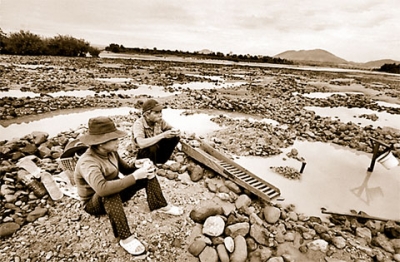|
The dead rivers
In rainy season,
the water rises and inundates houses, sweeping crops away. In dry season, the
drought chaps the fields. This is what happens with the people in the lower
course of the rivers in Central Highlands, where hydropower plants are
located.

Ba river is not only a part of the
millions of local people’s cultural life for the last thousands of years, but
also the livelihood for them, providing water to villages, residential
quarters in the southeast of Gia Lai and Phu yen provinces. The river, green
and clean, was a rich resource of fish for families’ meals.
Nevertheless, the peaceful life of
the people in the five districts and towns of the eastern part of Gia Lai and
the lower course has got upset since the day the An Khe – Ka Nak hydropower
plant became operational in September 2010.
The Ba River gets exhausted in the
dry season, thus making the stream stuck. The water flow is not strong enough
to sweep away the residues, seriously polluting the environment.
In the dry season, bad odor rises, shrouding
the whole An Khe town, turning it into the “dead land.” As the hydropower
plant blocks the river stream to store water for electricity generation
units, the people in the lower course have no more water for daily life and
watering crops.
The investor of An Khe – Ka Nak
plant, when considering the solutions to use the river’s water, should have
let the water flow to the lower course as arranged by “nature.” However, in
order to optimize the profits, they decided to drive the stream to Binh Dinh
province instead of Phu Yen province.
Anticipating the serious
consequences, Gia Lai and Phu Yen provincial authorities strongly protested
the plan. However, they could not do anything to change the minds of the
investor.
An Khe – Ka Nak would not be the only
hydropower plant on Ba river. Six power projects with the total capacity of
659 MW have been licensed by competent agencies. These include the 173 MW An
Khe – Ka Nak, 250 MW Ba Ha River, 70 MW Hinh River, 60 MW Dak Rong, 66 MW Ea
Krong Hnang and 40 MW Ba Thuong River.
Pham The Dung, Chair of the Gia Lai
provincial people’s committee, has many times expressed his worry about the
pollution of Ba River. He has urged the Ministry of Natural Resources and the
Environment to stipulate the minimum flow for Ba River, which the investors
will have to follow to ensure the normal water supply to local people.
The provincial authorities have also
suggested establishing the Ba River valley commission, in charge of giving
advices in the water resource management to the management agencies.
Gia Lai provincial authorities have
instructed the local agencies to strictly inspect the factories in the
locality and the implementation of the environment protection plan.
However, the river is still dying
because of the human’s behaviors.
According to the Hydropower Plant
Project Management Unit No. 7, belonging to the Electricity of Vietnam, the
water capacity after going through the An Khe dam must be as high as 4 cubic
meters per second. However, in fact, the water capacity in the dry season is
so weak that it cannot drive away the waste water from the factories on Ba
River side.
Thien Nhien
|
Thứ Sáu, 27 tháng 12, 2013
Đăng ký:
Đăng Nhận xét (Atom)
Không có nhận xét nào:
Đăng nhận xét